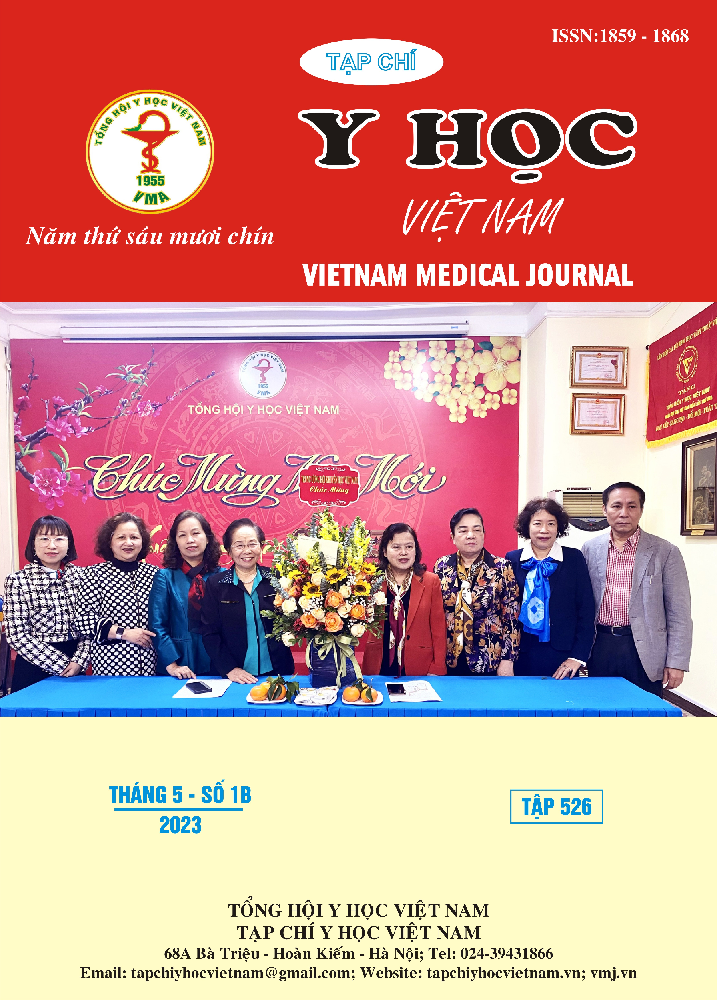CHARACTERISTICS OF HEMOPHILIC ARTHROPATHY IN X-RAY IMAGING AMONG PEDIATRIC HAEMOPHILIC PATIENTS IN CHILDREN HOSPITAL 1
Main Article Content
Abstract
Objectives: Describe characteristics of hemophilic arthropathy on X-ray films of pediatric patients with hemophilia and describe epidemiological, history, and clinical features of patients with and without hemophilic arthropathy on X-ray films. Subjects: Children with hemophilia, under 16 years old, treated in Hematology Department in Children Hospital 1 from July 2021 to August 2022. Methods: Case series reports, 42 patients with clinical joint symptoms and/or joint damages on ultrasonography underwent joint radiographs. Results: Among 42 patients, the rate of joint damage was 64.2%. In 150 joints surveyed, the rate of joint damage was 51,3%. Knee arthropathy was the most prevalent (41,5%), followed by ankle arthropathy (38,9%). The most common lesions were osteoporosis (52,4%), followed by bone hypertrophy (35,7%). The mean age of hospitalization of the group with arthropathy on X-ray (9,5 years old) was higher than that of the uninjured group (7,4 years old). The number of hospitalizations in the past 12 months for joint bleeding from 4 to 6 times was statistically different in the hemophilia group with joint damage compared with the hemophilia group without joint damage. The age at admission and the number of hospitalizations for joint bleeding were positively correlated with the Pettersson score. Conclusions: The rate of hemophilic arthropathy in 42 pediatric patients with hemophilia was 64,2% based on joint radiographs. Commonly injured joints are knee joints 41,5%, and ankle joints 38,9%. Common lesions of hemophilic arthropathy are osteoporosis, followed by hypertrophy of the ends of the bones. Age at admission and the number of hospitalizations for hemarthroses were positively correlated with the Pettersson score.
Article Details
Keywords
Hemophilia, hemophilic arthropathy, Pettersson score, X-ray
References
2. Trần Thị Phương Túy, Nguyễn Văn Tránh, Nguyễn Văn Bông (2009) "Tìm hiểu đặc điểm cơ xương khớp ở bệnh nhân hemophilia điều trị tại trung tâm Huyết học truyền máu". Y học Việt Nam, 3 (2), pp. 108-114.
3. Trương Vũ Trung, Nguyễn Xuân Hùng, Bạch Quốc Khánh (2018) "Nghiên cứu đặc điểm tổn thương khớp trên phim x-quang thường quy và một số yếu tố liên quan ở bệnh nhân hemophilia tại Viện Huyết học - Truyền máu trung ương năm 2016 - 2017". Y học Việt Nam, pp. 466:947- 953.
4. Chang C. Y., T. Y. Li, S. N. Cheng, et al. (2017) "Prevalence and severity by age and other clinical correlates of haemophilic arthropathy of the elbow, knee and ankle among Taiwanese patients with haemophilia". Haemophilia, 23 (2), pp. 284-291.
5. Chang C. Y., T. Y. Li, S. N. Cheng, et al. (2019) "Obesity and overweight in patients with hemophilia: Prevalence by age, clinical correlates, and impact on joint bleeding". J Chin Med Assoc, 82 (4), pp. 289-294.
6. Gupta S., K. Garg, J. Singh (2015) "Assessment of Musculoskeletal Function and its Correlation with Radiological Joint Score in Children with Hemophilia A". Indian J Pediatr, 82 (12), pp. 1101-6.
7. Pettersson H, Ahlberg A, Nilsson IM. A radiologic classification of hemophilic arthropathy. Clinical orthopaedics and related research. Jun 1980;(149):153-9.
8. World Federation of Hemophilia. Report on the Annual Global Survey 2019. 2019.


